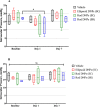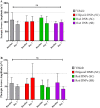Suprachoroidally Delivered DNA Nanoparticles Transfect Retina and Retinal Pigment Epithelium/Choroid in Rabbits
- PMID: 33364076
- PMCID: PMC7745627
- DOI: 10.1167/tvst.9.13.21
Suprachoroidally Delivered DNA Nanoparticles Transfect Retina and Retinal Pigment Epithelium/Choroid in Rabbits
Abstract
Purpose: This study evaluated ocular tolerability and transfectability of nonviral DNA nanoparticles (DNPs) after microneedle-based suprachoroidal (SC) administration, in comparison to subretinal (SR) administration.
Methods: The DNPs consisted of a single copy of plasmid DNA with a polyubiquitin C/luciferase transcriptional cassette compacted with 10 kDa PEG-substituted lysine 30-mer peptides (CK30PEG10k). New Zealand White rabbits (n = 4 per group) received a unilateral SC injection (0.1 mL via a microneedle technique) of ellipsoid-shaped DNPs, rod-shaped DNPs, or saline (negative control). A cohort of rabbits (n = 4) also received a single unilateral SR injection (0.05 mL via a transvitreal approach) of rod-shaped DNPs. At day 7, luciferase activity was measured in the retina and retinal pigment epithelium (RPE)-choroid via bioluminescence assay. A cohort of rabbits received a SC injection of analogous DNPs to assess spread of DNP injectate in the suprachoroidal space (SCS) via optical coherent tomography and histology.
Results: Suprachoroidal injection of DNPs resulted in reversible opening of the SCS circumferentially and posteriorly and was generally well tolerated, with no significant ocular examination score changes, intraocular pressure abnormalities, or changes in electroretinography amplitudes on day 7 compared to the baseline. High luciferase activity was observed in the retina and RPE-choroid of eyes that received SC DNPs (rod and ellipsoid shape) and SR DNPs (rod shape) compared to controls. The mean luciferase activity in RPE-choroid and retina was comparable between SC and SR administrations. Transfection in the RPE-choroid was approximately 10-fold higher than in the retina after either SC or SR administration of DNPs.
Conclusions: Suprachoroidal and SR administration of DNPs resulted in comparable transfection of retina and RPE-choroid.
Translational relevance: Suprachoroidal delivery of DNPs offers the potential to precisely target chorioretinal tissues while avoiding surgical risks associated with SR injection, and it may offer an office-based nonsurgical gene therapy option for the treatment of retinal diseases.
Keywords: DNA nanoparticles; chorioretinal diseases; nonviral gene therapy; suprachoroidal delivery.
Copyright 2020 The Authors.
Conflict of interest statement
Disclosure: V.S. Kansara, Clearside Biomedical, Inc. (E, F); M. Cooper, Copernicus Therapeutics (E, F); O. Sesenoglu-Laird, Copernicus Therapeutics (E, F); L. Muya, Clearside Biomedical, Inc. (E, F); R. Moen, Copernicus Therapeutics (E, F); T.A. Ciulla, Clearside Biomedical, Inc. (E, F)
Figures







Similar articles
-
Suprachoroidal Injection of Triamcinolone Acetonide Suspension: Ocular Pharmacokinetics and Distribution in Rabbits Demonstrates High and Durable Levels in the Chorioretina.J Ocul Pharmacol Ther. 2022 Jul-Aug;38(6):459-467. doi: 10.1089/jop.2021.0090. Epub 2022 Apr 11. J Ocul Pharmacol Ther. 2022. PMID: 35404132 Free PMC article.
-
Suprachoroidal delivery in a rabbit ex vivo eye model: influence of drug properties, regional differences in delivery, and comparison with intravitreal and intracameral routes.Mol Vis. 2013 May 30;19:1198-210. Print 2013. Mol Vis. 2013. Retraction in: Mol Vis. 2019 Feb 18;25:143. PMID: 23734089 Free PMC article. Retracted.
-
Suprachoroidal delivery of bevacizumab in rabbit in vivo eyes: Rapid distribution throughout the posterior segment.Eur J Pharm Biopharm. 2021 Dec;169:200-210. doi: 10.1016/j.ejpb.2021.10.003. Epub 2021 Oct 15. Eur J Pharm Biopharm. 2021. PMID: 34662718
-
Suprachoroidal Delivery of Viral and Nonviral Gene Therapy for Retinal Diseases.J Ocul Pharmacol Ther. 2020 Jul/Aug;36(6):384-392. doi: 10.1089/jop.2019.0126. Epub 2020 Apr 7. J Ocul Pharmacol Ther. 2020. PMID: 32255727 Free PMC article. Review.
-
Suprachoroidally injected pharmacological agents for the treatment of chorio-retinal diseases: a targeted approach.Acta Ophthalmol. 2019 Aug;97(5):460-472. doi: 10.1111/aos.14042. Epub 2019 Jan 31. Acta Ophthalmol. 2019. PMID: 30702218 Review.
Cited by
-
What's New in Ocular Drug Delivery: Advances in Suprachoroidal Injection since 2023.Pharmaceuticals (Basel). 2024 Jul 30;17(8):1007. doi: 10.3390/ph17081007. Pharmaceuticals (Basel). 2024. PMID: 39204112 Free PMC article. Review.
-
Evaluation of Long-Lasting Potential of Suprachoroidal Axitinib Suspension Via Ocular and Systemic Disposition in Rabbits.Transl Vis Sci Technol. 2021 Jun 1;10(7):19. doi: 10.1167/tvst.10.7.19. Transl Vis Sci Technol. 2021. PMID: 34128964 Free PMC article.
-
Characterization and validation of a chronic retinal neovascularization rabbit model by evaluating the efficacy of anti-angiogenic and anti-inflammatory drugs.Int J Ophthalmol. 2022 Jan 18;15(1):15-22. doi: 10.18240/ijo.2022.01.03. eCollection 2022. Int J Ophthalmol. 2022. PMID: 35047351 Free PMC article.
-
Suprachoroidal Injection: A Novel Approach for Targeted Drug Delivery.Pharmaceuticals (Basel). 2023 Sep 1;16(9):1241. doi: 10.3390/ph16091241. Pharmaceuticals (Basel). 2023. PMID: 37765048 Free PMC article. Review.
-
Potential of miRNA-Based Nanotherapeutics for Uveal Melanoma.Cancers (Basel). 2021 Oct 16;13(20):5192. doi: 10.3390/cancers13205192. Cancers (Basel). 2021. PMID: 34680340 Free PMC article. Review.
References
-
- US Food and Drug Administration. FDA approves novel gene therapy to treat patients with a rare form of inherited vision loss. Available at: https://www.fda.gov/news-events/press-announcements/fda-approves-novel-g.... Accessed June 3, 2020.
-
- Moore NA, Morral N, Ciulla TA, Bracha P. Gene therapy for inherited retinal and optic nerve degenerations. Expert Opin Biol Ther. 2018; 18(1): 37–49. - PubMed
-
- Seidman C, Kiss S. Gene therapy: the next frontier for treatment of acquired and inherited ocular disorders. Retina Today. 2015;69–71.
-
- Moore NA, Bracha P, Hussain RM, Morral N, Ciulla TA. Gene therapy for age-related macular degeneration. Expert Opin Biol Ther. 2017; 17(10): 1235–1244. - PubMed
MeSH terms
Substances
LinkOut - more resources
Full Text Sources
Research Materials
Miscellaneous

